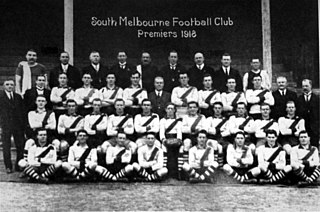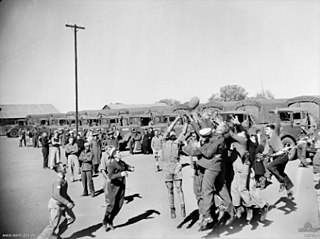Related Research Articles

The South Australian National Football League, or SANFL, is an Australian rules football league based in the Australian state of South Australia. It is also the state's governing body for the sport.
1919 in sports describes the year's events in world sport. Although World War I had ended in 1918, the influenza pandemic and planning difficulties from the war still curtailed sport to a considerable extent.
1941 in sports describes the year's events in world sport.

Hindmarsh Stadium is a multi-purpose stadium in Hindmarsh, an inner western suburb of Adelaide, South Australia. It is the home of the Australian A-League team, Adelaide United.

The 1917 VFL season was the 21st season of the Victorian Football League (VFL), the highest level senior Australian rules football competition in Victoria.

The 1916 VFL season was the 20th season of the Victorian Football League (VFL), the highest level senior Australian rules football competition in Victoria.

The 1918 VFL season was the 22nd season of the Victorian Football League (VFL), the highest level senior Australian rules football competition in Victoria.
The 1919 VFL season was the 23rd season of the Victorian Football League (VFL), the highest level senior Australian rules football competition in Victoria.
Dan Moriarty was a champion Australian rules footballer in the South Australian Football League, considered to be one of the greatest centre half-backs in the history of the sport.

Australian rules football was heavily affected by both World War I and World War II. Hundreds of leading players served their country abroad, and many lost their lives. On the home front, competitions like the Victorian Football League (VFL) went ahead during these wars, but faced many restrictions.

The 1940 VFL Lightning Premiership was an Australian rules football knockout competition played entirely on Saturday, 3 August 1940, at the Melbourne Cricket Ground (MCG). It was played during a week's break of the Victorian Football Leagues's 1940 season between Rounds 14 and 15. It was contested by the 12 teams who competed in the 1940 VFL season. A total of 30,407 witnessed the day's matches. St Kilda won the lighting premiership competition, defeating Richmond in the final by 24 points. It was the first premiership of any kind at any grade that the St Kilda Football Club had won in its history.
Lightning football is a shortened variation of Australian rules football, often played at half of the duration of a full match.
The 1915 Victorian Football Association season was the 39th season of the Australian rules football competition.

The 1942 SANFL Grand Final was an Australian rules football game contested between a merger teams of Port Adelaide–West Torrens ("Port–Torrens") and West Adelaide–Glenelg ("West–Glenelg"), held at the Adelaide Oval on Saturday 19 September 1942. It was the 44th annual Grand Final of the South Australian National Football League, stated to determine the premiers of the 1942 SANFL season. The match, attended by 35,000 spectators, was won by Port–Torrens by a margin of 11 points, marking that mergers first premiership.

The South Australian Patriotic Football League or Patriotic League was a short lived Australian rules football wartime competition formed during World War I in South Australia to fill the void left by the South Australian Football League (SAFL) which elected to go into recess at the time. Games held were used to raise funds for the war effort. The SAFL was opposed to the formation of the Patriotic League and refused to recognise it during and after World War I.

The 1916 SAPFL Grand Final was an Australian rules football game contested between the Port Adelaide Football Club and the West Torrens Football Club, held at Hindmarsh Oval on Saturday 19 August 1916. It was the 1st Grand Final of the South Australian Patriotic Football League, staged to determine the premiers of the 1916 SAPFL season. The match was won by Port Adelaide by a margin of 34 points, marking that clubs first patriotic premiership victory.

The 1917 SAPFL Grand Final was an Australian rules football game contested between the Port Adelaide Football Club and the West Torrens Football Club, held at Alberton Oval on Saturday 1 September 1917. It was the 2nd Grand Final of the South Australian Patriotic Football League, staged to determine the premiers of the 1917 SAPFL season. The match was won by Port Adelaide by a margin of 16 points, marking that clubs second patriotic premiership victory.

The 1918 SAPFL Grand Final was an Australian rules football game contested between the West Torrens Football Club and the West Adelaide Football Club, held at Jubilee Oval on Saturday 9 October 1918. It was the 3rd Grand Final of the South Australian Patriotic Football League, staged to determine the premiers of the 1918 SAPFL season. The match was won by West Torrens by a margin of 14 points, marking that clubs first patriotic premiership victory.

The 1916 SAPFL season was the 1st season of the South Australian Patriotic Football League, a competition formed in the absence of the South Australian Football League during World War I. The SAFL was opposed to the formation of the Patriotic League and refused to recognise it during and after World War I. Hindmarsh Oval was the contingency venue for the 1916 SAPFL Grand Final if an agreement with the SACA could not be reached as the Adelaide Oval was the preferred venue of the SAPFL.

The 1918 SAPFL season was the 3rd and final season of the South Australian Patriotic Football League, a competition formed in the absence of the South Australian Football League during World War I. The SAFL was opposed to the formation of the Patriotic League and refused to recognise it during and after World War I.
References
- ↑ "South Australian football in wartime". australianfootball.com. Retrieved 28 September 2019.